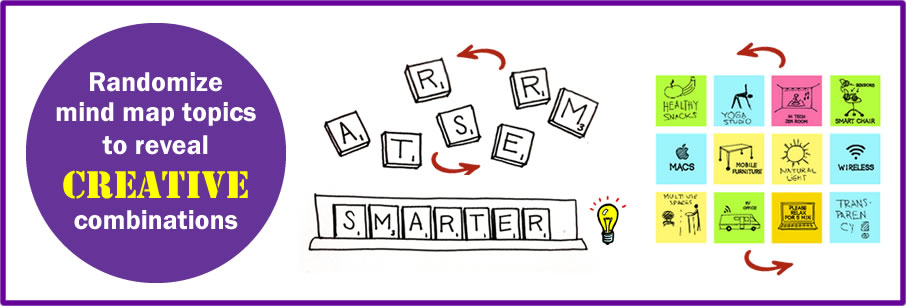What do Scrabble, sticky note and index card brainstorming and mind mapping software have in common? All four benefit from randomizing elements, which can help us to see new patterns, opportunities and ideas.
This article was inspired by a blog post by Megan Landes at Mural.ly, who recalled how she took a one-semester college class on strategies for playing the game Scrabble. One of the techniques she learned from her expert teacher at UC Berkeley was that of shuffling your letter tiles, which reveals patterns and combinations of letters that frequently result in higher word scores.
The biggest benefit of shuffling your letter tiles around in Scrabble, according to Landes, is to help you identify not one word, but many possibilities. In much the same way, randomizing your ideas helps to increase the number number and quality of your ideas, and helps to prevent you from locking on to “the first right idea.” Your first good idea may be the best solution to the challenge you face. But then again, it may not be. This process keeps you open to possibilities, Landes points out.
“In order for us to fully appreciate the full range of possible solutions that come from our ideas, we need to be able to move them around – to organize them in different ways so that we can make more connections and open up more possible solutions,” she explains.
Rearranging your ideas also helps to prevent premature categorization, which once again may prevent us from uncovering the best possible solution:
“Shuffling our ideas around is beneficial for understanding in the same way daydreaming is good for creativity,” she continues. “When we unbind our ideas from the way we have them categorized initially, they are able to mix and mingle and connect in ways we may not have connected them on our own. On the other hand, when we fixate on one possible solution, we limit ourselves from being able to see the rest of the possibilities.”
When brainstorming using sticky notes or index cards, it’s often valuable move ideas around, grouping and regrouping them into different combinations with complete freedom. This practice often leads to idea improvement and new ideas. The same principle applies to mind mapping.
When you move an idea to a different part of your mind map, you change its context, and therefore its meaning. Your ideas may look promising as you ponder them within the initial structure of your mind map. But they begin to take on much greater value when you begin to move them into random combinations and consider the new relationships between them and the patterns they form. As you look at them in their new configuration, they may suggest new ideas and opportunities that you wouldn’t have been able to see otherwise.
This process mirrors the way your subconscious mind works. It functions by digesting the information you feed your brain, breaking it down into smaller chunks, combining and recombining them and then surfacing promising combinations as ideas or hunches.
One of the biggest benefits of using mind mapping software to synthesize and improve you ideas is this: If you move a topic to a new location and it doesn’t reveal any new insights, you can always use the “undo” command to return it to its previous location. This encourages, even invites, experimentation and “What if?” thinking. You can also add new first-level topics to create additional categories or “buckets” for your ideas at any time, classifying and re-classifying them as you go.
All of this helps you create and identify the best possible solutions. The next time you’re generating ideas to tackle a business challenge or opportunity, make sure you take time for synthesis. You’ll be glad you did!


Leave a Reply